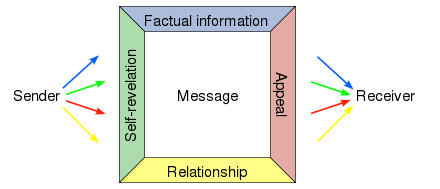Four-sides model
The four-sides model (also known as communication square or four-ears model) is a communication model by Friedemann Schulz von Thun. According to this model every message has four facets[1] though not the same emphasis might be put on each. The four sides of the message are fact, self-revealing, relationship, and appeal.

Relationship
The communication square describes the multi-layered structure of human utterances. It combines the idea of a postulate (second axiom) from Paul Watzlawick, that every message contains content and relational facets, with the three sides of the Organon model by Karl Bühler, that every message might reveal something about the sender, the receiver, and the request at hand. Such models are familiar in the linguistic community as part of speech act theory.
The four sides of communication
- The Factual Level contains statements which are matter of fact like data and facts, which are part of the news.
- In the self-revealing or self-disclosure the speaker - conscious or not intended - tells something about himself, his motives, values, emotions etc.
- In the Relationship-layer is expressed resp. received , how the sender gets along with the receiver and what they think of them.
- The Appeal contains the desire, advice, instruction and effects that the speaker is seeking.
Every layer can be misunderstood individually. The classic example of Schulz von Thun is the front-seat passenger who tells the driver: "Hey, the traffic lights are green". The driver will understand something different, depending on the ear with which he will hear, and will react differently. (On the matter layer he will understand the "fact" "the traffic lights are green", he could also understand it as "Come on, drive! ."-"command", or on the "relationship" could hear a help like "I want to help you, or if he hears behind it: I am in a hurry the passenger reveals part of himself "self-revelatory".") The emphasis on the four layers can be meant differently and also be understood differently. So the sender can stress the appeal of the statement and the receiver can mainly receive the relationship part of the message. This is one of the main reasons for misunderstandings.
The Factual Level
What I inform about:
On the factual level the sender of the news gives data, facts and statements. It is the task of the sender to send this information clearly and understandably.
The receiver proves with the Factual ear, whether the matter message fulfills the criteria of truth (true/untrue) or relevance (relevant/irrelevant) and the completeness (satisfying/something has to be added).
In a long-term team, the matter layer is clear and needs only a few words.
The self-revealing
What I reveal about myself:
In every news there is information about the sender. On the layer of the self-revealing or self-disclosure the sender reveals himself. This message consists of conscious intended self-expression as well as unintended self-revealing, which is not conscious to the sender (see also Johari window). Thus, every news becomes information about the personality of the sender.
The self-revealing ear of the receiver perceives which information about the sender is hidden in the message.
The relationship indicator
What I think about you (you-statement) and how we get along (we-statement):
The relationship layer expresses how the sender gets along with the receiver and what he thinks about him. Depending on how he talks to him (way of formulation, body language, intonation ...) he expresses esteem, respect, friendliness, disinterest, contempt or something else.
Depending on which message the receiver hears with relationship ear, he feels either depressed, accepted or patronized. A good communication is distinguished by communication from mutual appreciation.
The appeal
What I want to make you do:
Who states something, will also affect something. This appeal-message should make the receiver do something or leave something undone. The attempt to influence someone can be less or more open (advice) or hidden (manipulation).
On the Appeal ear the receiver asks himself: "What should I do, think or feel now?"
citation: " Mothers are very appeal-influenced by children." Mum! The shoes .... Yes! I'll be right there to put them on for you.
Example
Two people are eating a home-cooked meal together.
The one who didn't cook says: "There is something green in the soup."
- Sender
Factual level: There is something green. Self-revealing layer: I don't know what it is. Relationship layer: You should know what it is. Appeal layer: Tell me what it is!
- Receiver
Factual level: There is something green. Self-revealing layer: You do not know what the green item is, and that makes you feel uncomfortable. Relationship layer: You think my cooking is questionable. Appeal layer: I should only cook what you know in the future!
The other answers: "If you don't like the taste, you can cook it yourself."
See also
- Karl Bühler: Organon-Modell
- communication theory
- Organon model
- Roman Jakobson: communication model
- Speech act
- Subtext
- Interpersonal communication
References
Bibliography
- Friedemann Schulz von Thun: Miteinander reden: Störungen und Klärungen. Psychologie der zwischenmenschlichen Kommunikation. Rowohlt, Reinbek 1981. ISBN 3-499-17489-8